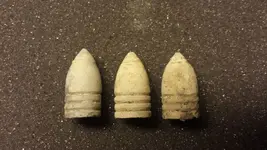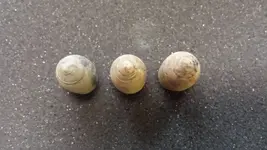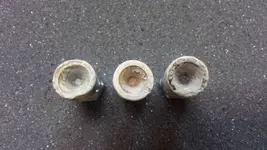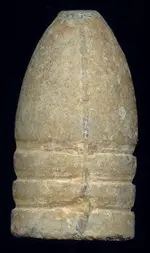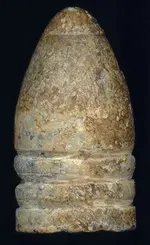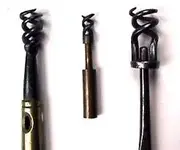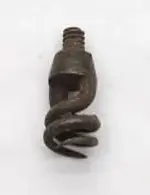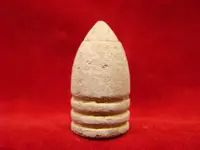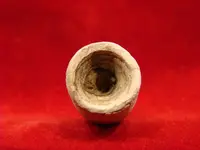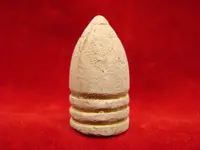Your 3-groove Minie bullets are a Confederate-made variety, because they are "nose-cast"... meaning the sprue from the filler hole in the bulletcasting mold is located on the bullet's nose-tip. Instead of being snipped off by the bullet's manufacturer (which is the normal procedure), each of yours had its projecting nose-sprue presssed down by a cone-shaped press, similar to the mouth of a ramrod. In your case, the lower circular groove has a slight pushed-up mound of lead below it, which tells me the cone-shaped press was pushed down onto the bullet's nose too hard, leaving an imprint of its circular lip below the sprue-line. I'm sure the imprint wasn't done by a ramrod because your bullets show absolutely no evidence of having been fired -- nor "pulled." (For certainty about that, I had to enlarge your photos and look very closely to make sure the grooves encircing each bullet's nose-tip were concentric, not the spiral which a bulletworm creates.)
If the conical press had not been used to almost totally compress away the casting-sprue on your bullets, they would have been called Confederate "cap-nose" bullets.
About "nose-cast" meaning Confederate-made:
The only yankee-made Minie bullets that I can think of at the moment which were nose-cast are the Williams Regulation type, which was formerly but incorrectly called a Harpers Ferry Pistol-Carbine minie. All three versions of the Williams Patent "Bore-Cleaner" bullets are nose-cast, but they are not Minie bullets. By definition, all the versions of Minie bullet have a large-sized cavity in their base. I said "large" in order to exclude the small cavity found in some version of Sharps bullets, and some pistol bullets.
An important Caution-note about identifying nose-cast bullets:
Many-many times, I've seen pointed nose bullets whose nose-tip got flattened "accidentally" -- meaning it's not a nose-cast bullet, it is just a damaged pointed-nose bullet. Those can easily be mistaken for a snipped-nose nose-cast bullet. Actual nose-cast bullets whose casting sprue got snipped (cut off with pincers) tend to show a crisp clean cut, usually perfectly-flat and sometimes showing a slight raised line in the center of the flat spot, showing where the cutting jaws of the pincer met. For a good example of a true snipped-nose nose-cast minie, see the photo below. The other photos show and nose-cast minie with uncut sprue, and a "cap-nose" minie.
For anybody who is still not quite clear about what a nose-cast minie's nose tip looks like, and what a "snipped sprue" nose-cast minie looks like... all Confederate Gardner minies were nose-cast, and many of them had their projecting casting sprue snipped off, creating a "flat-tipped" Gardner.



